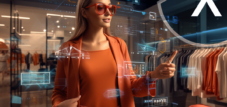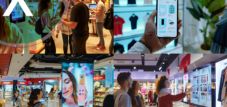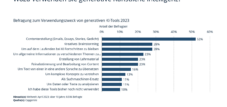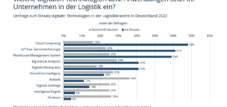The future of retail / Survey: Digital, hybrid and with artificial intelligence – VCommerce meets traditional store visits
Language selection 📢
Published on: August 4, 2024 / update from: August 4, 2024 - Author: Konrad Wolfenstein

The future of retail / Survey: Digital, hybrid and with artificial intelligence – VCommerce meets traditional store visits – Image: Xpert.Digital
🛍️ How digital is retail?
🛒🤖 One in four traders consider artificial intelligence (AI) to be a passing trend. But opinions differ: 56 percent of retailers see AI as crucial to competitiveness in the future, although only 4 percent have actually used this technology so far.
The future of shopping lies in both virtual shopping trips and traditional store visits. Customers have the choice between personal advice on site and AI-supported recommendations in the web shop, strolling through busy city centers or conveniently comparing and ordering offers online. This hybrid approach is becoming increasingly popular: 85 percent of German retail companies offer their products and services both online and stationary. Before the pandemic in 2019, this proportion was 66 percent, and in 2021 it was already 77 percent. Currently only 8 percent of German retailers are only active in brick-and-mortar locations, compared to 16 percent in 2021 and 25 percent in 2019. These figures come from a representative survey of 503 retail companies in Germany, carried out on behalf of the digital association Bitkom.
“The corona pandemic has given online retail a significant boost and permanently changed customers’ shopping behavior,” explains Dr. Bernhard Rohleder, CEO of Bitkom. “This trend is now continuing, with more and more retailers expanding their online activities – but also continuing to do business locally.”
The proportion of companies that use both sales channels and make at least half or more of their total sales from their online business will rise to 30 percent this year. In 2018 this value was 8 percent, in 2020 it was 19 percent. However, pure online sales remain stable: only 5 percent of retailers sell exclusively online in 2023, comparable to 6 percent in 2021 and 2019.
29 percent of hybrid retailers can imagine selling exclusively online in the future. But the end of stationary retail is not in sight: Only 12 percent of retail companies believe that stationary retail has no future. In contrast, 71 percent are of the opinion that stationary retail needs to reinvent itself.
🏪 Challenges and innovations in stationary retail
Brick-and-mortar retail is facing some challenges. 68 percent of retailers say that they cannot keep up with the low prices online. 54 percent see virtual shopping experiences with augmented reality (AR) and virtual reality (VR) as increasing competition.
Nevertheless, the vast majority of retail companies are already relying on digital technologies: 88 percent of brick-and-mortar retailers use cashless payment via smartphone or smartwatch as standard, and a further 6 percent are planning to do so. 79 percent of their customers offer WiFi, 7 percent are planning or discussing it.
Click & Collect is also widespread: 73 percent of stationary retailers offer this service, while 10 percent are discussing it or planning it. In addition, 52 percent of retailers use tablet or smartphone-based systems at the checkout, and a further 23 percent are planning or discussing their use. One in three retailers use tablet PCs and interactive screens for product information, and 34 percent are planning or discussing this.
Digital price tags are used by 32 percent of stationary retailers, and 37 percent are planning or discussing them. Only 10 percent currently offer seamless checkout solutions, and a further 19 percent are planning or discussing this.
🤖 Artificial intelligence: potential and skepticism
Although 56 percent of retailers see AI as crucial to their competitiveness, only 4 percent are currently using this technology. 15 percent are planning or discussing the deployment, while 77 percent do not yet have the topic on their agenda.
73 percent of traders wait to see what experiences others have with AI technologies like ChatGPT before investing themselves. 61 percent say they lack the staff to implement AI. “Wait and see is rarely a good strategy. The barriers to entry for the use of AI are currently lower than ever before,” emphasizes Dr. Rawhide. “From customer service to advertising campaigns, from purchasing planning to product launches – AI can be used sensibly almost everywhere in retail.”
However, there are also concerns: 76 percent of retail companies fear that the use of AI in customer service could lead to alienation from customers. 72 percent worry about possible damage caused by masses of AI-generated fake reviews.
Retailers see the potential of AI in retail primarily in inventory management (85 percent), text generation (82 percent) and personalized recommendations (76 percent). Many retailers also see great potential in customer service and customer communication (69 percent) as well as in price optimization and visual product search (48 percent each).
🛒 Trade 2030: Future visions and technologies
In tomorrow's retail, not only AI but also other technologies will play a central role. 77 percent of retailers believe that by 2030, cash register systems will no longer be used in brick-and-mortar stores, but that payment will be automatic when you leave the store. 69 percent expect autonomous vehicles to deliver products directly to their door.
54 percent of retailers believe that virtual shopping worlds like the Metaverse, where you can shop in digital environments and interact with other people, will be widespread. Just as many people believe that retail will be open around the clock and that AI will recognize used-up products in the home and reorder them independently. 42 percent expect that by 2030 products will have an unalterable digital image that provides information about production conditions and authenticity. 19 percent see holographic product presentations as a future trend.
However, there are also challenges: Two thirds of retail companies see themselves as laggards when it comes to digitalization. Three percent even say they missed the boat. Only 23 percent see themselves as pioneers, 4 percent as at the top.
📦 E-commerce: Versatile sales channels
In the area of e-commerce, 93 percent of trading companies with online trading rely on their own shop on the website. 87 percent offer orders via email, and 69 percent sell their products via online marketplaces and sales platforms. Social media platforms are used by 23 percent, and 13 percent offer a company app.
Although online retail is flourishing, many retailers continue to use traditional ordering methods: 63 percent accept orders by fax, 57 percent by telephone or mail. This shows that trade is not yet fully digitalized and traditional methods still play a role.
The future of retail is clearly digital, but also hybrid. Artificial intelligence, innovative technologies and new distribution channels will play a crucial role. Brick-and-mortar retail will have to reinvent itself in order to keep pace with digital developments. The challenges are great, but so are the opportunities. Tomorrow's commerce will take place both online and offline - supported by advanced technologies and flexible business models.
📣 Similar topics
- 📣 A quarter of traders: AI just a passing trend?
- 🛒 Future of shopping: Hybrid model on the rise
- 🌐 Online and offline trading: statistics and developments
- 📱 Digital progress: cashless payments and more
- 💡 Artificial intelligence: potential and challenges
- 🤖 2030: Visions of future retail
- 🔍 Virtual shopping tours: AR and VR in retail
- 📊 Corona and e-commerce: Sustainable changes
- 🏪 Stationary retail: New invention required?
- 🛠️ Technologies and inventory management: The role of AI
#️⃣ Hashtags: #HandelDerZukunft #KünstlicheIntelligenz #Hybridhandel #DigitaleTransformation #ECommerce
Our recommendation: 🌍 Limitless reach 🔗 Networked 🌐 Multilingual 💪 Strong sales: 💡 Authentic with strategy 🚀 Innovation meets 🧠 Intuition
At a time when a company's digital presence determines its success, the challenge is how to make this presence authentic, individual and far-reaching. Xpert.Digital offers an innovative solution that positions itself as an intersection between an industry hub, a blog and a brand ambassador. It combines the advantages of communication and sales channels in a single platform and enables publication in 18 different languages. The cooperation with partner portals and the possibility of publishing articles on Google News and a press distribution list with around 8,000 journalists and readers maximize the reach and visibility of the content. This represents an essential factor in external sales & marketing (SMarketing).
More about it here:
🌟 Innovation in customer service: The role of service robots and artificial intelligence in traditional stores

Innovation in customer service: The role of service robots and artificial intelligence in traditional stores - Xpert.Digital
🔍 In an era of ever-advancing technological developments, retail has undergone significant change. While online shopping dominates the market, traditional physical stores remain relevant and try to keep up with modern innovations. One of these innovations is the integration of service robots and artificial intelligence (AI) to improve customer service and create new, engaging experiences for customers, especially for the younger target group.
🤖 The integration of robotic technology in retail
Service robots in retail are no longer a distant dream of the future; they are reality. These advanced machines not only serve as eye-catchers, but also actively improve the customer experience and reduce the burden on staff. These robots, often humanoid in design, can greet customers, guide them through the store, answer questions and recommend products.
An example of this is the "Pepper" robot, which is used in many shops worldwide. With his ability to react emotionally to customers and presenting them with products, he creates interactive and personalized shopping experience. "The integration of robot technology in the shop not only revolutionized customer service, but also promotes an emotional bond between the brand and the customer."
🔍 Artificial intelligence as the heart of modern customer advice
Artificial intelligence plays a crucial role in the advancement of customer service. AI-driven systems can analyze huge amounts of data and use it to offer personalized recommendations and services. In retail, AI can be used to individually target customers based on their purchasing habits and preferences.
By analyzing customer interactions and purchasing data, AI systems can precisely predict which products could be interesting for a specific customer. This leads to much more personalized advice, which goes far beyond what human sellers could do alone. "With the power of artificial intelligence, retail can make the shopping experience more individual and thus significantly increase customer satisfaction and loyalty."
🎮 Gamification: A playful approach to customer loyalty
Another innovative approach to customer service is the use of gamification. This refers to the integration of playful elements and techniques into the purchasing process. Gamification not only makes the shopping experience more interactive and entertaining, but also increases customers' motivation to stay in the store longer and come back more often.
For example, through the use of AR (augmented reality) and VR (virtual reality), customers can discover and experience products in a playful way. In a game they can collect virtual rewards, which in turn can be converted into real discounts and offers. This type of interaction particularly appeals to the younger target group who are tech-savvy and have a strong interest in digital experiences.
👍 The advantages for the traditional retail store
The combination of service robots, AI and gamification brings a variety of advantages for traditional retail stores:
1. Improved efficiency and productivity
Service robots can take on repetitive tasks, freeing up staff and allowing them to focus on more complex customer requests.
2. Personalized customer experience
AI-powered analytics and recommendations make the shopping experience more personalized and tailored to the needs and desires of each customer.
3. Increased customer loyalty
Gamification strategies ensure a more entertaining and involving shopping experience, which particularly appeals to younger customer groups and motivates them to come to the store more often.
4. Innovative competitive advantage
Using the latest technology in retail can help you stand out from the competition and be seen as an innovative company.
🛠️ Challenges and solutions
Despite the numerous benefits, there are also challenges in integrating these technologies into retail. One of the biggest hurdles is acceptance by customers and staff. Many people are initially skeptical about new technologies. To address this problem, it is important to clearly communicate the benefits and ease of use of the new systems and to train staff accordingly.
Another point is data security. Using AI requires handling large amounts of customer data, which raises privacy concerns. Companies must ensure that all data is stored and processed securely and complies with applicable data protection regulations.
🌐 The future of retail
The constant development of new technologies will continue to shape retail in the future. Augmented reality, virtual reality and other advanced technologies offer enormous potential for improving customer service and creating unique shopping experiences. A store that successfully integrates these technologies can not only increase its efficiency, but also build a deeper connection with its customers.
It is becoming apparent that by combining traditional and digital shopping experiences, retail is becoming a hybrid model that combines the advantages of both worlds. The key to success is always listening to customer needs and being willing to find innovative ways to meet those needs.
In a world where technological innovation continues to create new opportunities, it is up to retailers to recognize and capitalize on these opportunities. With service robots, artificial intelligence and gamification, stores can not only stay competitive, but also delight their customers in completely new and exciting ways. The future of retail is exciting and promising - a future where technological innovation and traditional values go hand in hand to create an outstanding shopping experience.
📣 Similar topics
- 🤖 Innovation in customer service: The revolution through service robots and AI
- 🛒 Modern technologies in retail: service robots and their advantages
- 🧠 Artificial Intelligence: The key to personalized shopping experiences
- 👋 A special kind of welcome: service robots in action
- 🎮 Gamification in retail: playful customer loyalty
- 🔍 AI-powered recommendations: Understand the customer better
- 🎯 Revolutionary sales strategies: benefits and advantages of gamification
- 🔧 Challenges in integrating new technologies in retail
- 💡 Retail is changing: Modern technologies and their effects
- 🌐 Future visions in retail: The integration of AR and VR
#️⃣ Hashtags: #Innovation #ServiceRobots #ArtificialIntelligence #Gamification #Retail
We are there for you - advice - planning - implementation - project management
☑️ SME support in strategy, consulting, planning and implementation
☑️ Creation or realignment of the digital strategy and digitalization
☑️ Expansion and optimization of international sales processes
☑️ Global & Digital B2B trading platforms
☑️ Pioneer Business Development
I would be happy to serve as your personal advisor.
You can contact me by filling out the contact form below or simply call me on +49 89 89 674 804 (Munich) .
I'm looking forward to our joint project.
Xpert.Digital - Konrad Wolfenstein
Xpert.Digital is a hub for industry with a focus on digitalization, mechanical engineering, logistics/intralogistics and photovoltaics.
With our 360° business development solution, we support well-known companies from new business to after sales.
Market intelligence, smarketing, marketing automation, content development, PR, mail campaigns, personalized social media and lead nurturing are part of our digital tools.
You can find out more at: www.xpert.digital - www.xpert.solar - www.xpert.plus



























